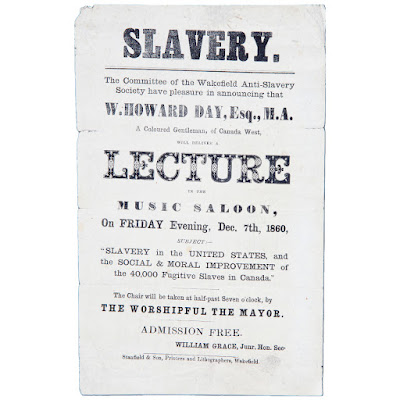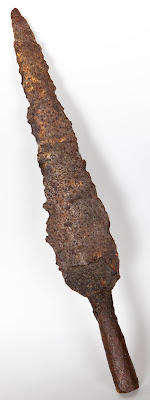Stitching Friendships is a new display in Wakefield Museum. It was created with the Refugee Council.
It showcases the work of the Refugee Council’s sewing and embroidery group in Wakefield.
.JPG) |
| The Stitching Friendships display in Wakefield Museum |
The group was set up in 2023. It aimed to create a safe
environment for women to discover and develop their talents.
Many of the women came from different countries and spoke
different languages. Despite this, they were able to share practical skills
with each other.
The women in the group are from Sudan, Afghanistan, and
Eritrea. They were forced to leave their homes because of violence, conflict,
and persecution. They moved to a new and unknown country under difficult
circumstances. The sewing group allowed them to make friends and practice their
English.
As well as their work, the women shared their stories of
leaving their home countries and moving to Wakefield. They shared these stories
via a translator.
Read on to discover their stories in English, Arabic and Dari.
Content warning: Contains stories referring to racism, war and conflict.
Abeer
Abeer’s work: Abeer created an embroidery inspired by
the nature of Sudan. It features birds, flowers and trees. The embroidery
brings back memories for Abeer of her home country and family trips to the
river. They would have a picnic, drink Arabic coffee, sing and dance.
Abeer’s story: Abeer was born in Sudan. Civil war in
Sudan has resulted in serious attacks and abuses on civilians, and led to mass
displacement. Abeer was forced to leave her home and move to Egypt, where she
stayed for five years. She experienced racism, bullying and health issues in
Egypt, so she moved to the UK in 2021.
عبير
ولدت
عبير في السودان. لقد
أُجبرت على ترك منزلها والانتقال إلى مصر حيث بقيت لمدة خمس سنوات. عانت من العنصرية
ومشاكل صحية في مصر، لذا انتقلت إلى المملكة المتحدة في عام ٢٠٢١.
قطعة
عبير مستوحاة من طبيعة السودان وتعيد ذكريات الرحلات العائلية إلى النهر، حيث كانوا
يقومون بنزهة ويشربون القهوة العربية ويغنون ويرقصون.
عبیر
عبیردر سودان به دنیا آمد. او مجبور شد
خانه خود را ترک کند و به مصر نقل مکان کند و پنج سال در آنجا بماند. او در مصر از
مسائل تبعیض نژادی و نبود خدمات صحی رنج می برد، بنابراین در سال ۲۰۲۱ به بریتانیا
نقل مکان کرد.
کارساخته عبیراز طبیعت سودان الهام گرفته شده است که خاطرات رفت و
آمدهای خانوادگی به کنار دریا را یادآورمی شود، جایی که آنها برای میله فامیلی
میرفتند, قهوه عربی می نوشیدند، , آواز می
خواندند و می رقصیدند
Gulchehra
Gulchehra’s work: Gulchehra chose to make a patchwork
cover. She wanted to rescue the pieces of fabric that no one else wanted and
turn them into something new.
Gulchehra’s story: Gulchehra was born in Afghanistan.
The country has experienced more than 40 years of conflict, natural disasters,
and poverty. In 2021, the Taliban’s takeover of Kabul increased the violence
and suffering. Gulchehra was forced to flee her home. She hid in a secret
location in Kabul before coming to the UK. She still has family in Afghanistan.
Gulchehra has found it difficult to make friends in Wakefield because there are
few Afghan families. Sometimes she feels lost here.
Gulchehra joined the sewing group to meet new people. She
has made two good friends.
جولتشيهرا
ولدت
جولتشيهرا في أفغانستان. أُجبرت على الفرار من منزلها، واختبأت في مكان سري في مدينة
كابول قبل القدوم إلى المملكة المتحدة. لقد كافحت لتكوين صداقات في مدينة ويكفيلد
بسبب قلة عدد العائلات الأفغانية.
انضمت
جولتشيهرا إلى مجموعة الخياطة للقاء أشخاص جدد. لقد اختارت إنقاذ قطع القماش التي
لم يرغب بها أحد وتحويلها إلى قطعة مرقعة.
گلچهره
گلچهره در افغانستان بدنیا آمد. او که مجبور به
فراراز خانه اش شد، قبل از آمدن به بریتانیا در یک مکان مخفی در کابل پنهان بود. او برای یافتن
یک دوست در منطقه ویکفیلد تلاش کرد اما موفق نشد زیرا تعداد کمی از خانواده های
افغان در آنجا وجود زندگی میکنند.
گلچهره به گروپ خیاطی پیوست به این امید که با خانم های
جدید آشنا شود. او تصمیم گرفت توته های تکه های را که هیچ کس دیگری کارنداشت
و استفاده نمیکرد دوباره استفاده کند و ازآنها یک تکه وصله کاری یا به اصطلاح یک
پارچه پینه دوزی درست کند.
Halima
Halima’s work: Halima loves sewing. She made a pair
of velvet trousers because she likes to wear trousers under her clothes to keep
warm and covered. She told us the fabric is perfect because it’s not too hot
and not too cold.
Halima’s story: Halima was born in Eritrea. Many
people consider the country to have one of the world’s most repressive
governments. It has harsh military conscription, political imprisonment, and
widespread torture and abuse. Halima was forced to leave Eritrea and move to
Egypt, where she lived for six years. She was then brought to the UK by the
United Nations because her son needed medical treatment. She arrived here in
March 2023.
Halima joined the group to learn new skills and socialise.
It offered her an opportunity to gather together with other women. She told us
that all of the women in the group have become her friends.
حليمة
ولدت
حليمة في إريتريا. غادرت إريتريا وانتقلت إلى مصر، قبل أن تحضرها الأمم المتحدة
إلى المملكة المتحدة لأن ابنها كان بحاجة إلى علاج طبي.
حليمة
تحب الخياطة كثيرا. انضمت إلى المجموعة لتعلم مهارات جديدة والتواصل الاجتماعي.
لقد صنعت بنطلون مخملي لأنها تحب ارتداء البنطلون تحت ملابسها للتدفئة والتغطية.
حلیمه
حلیمه در اریتریا بدنیا آمد. او کشورش اریتریا
را ترک کرد و به مصر نقل مکان کرد، قبل از اینکه توسط سازمان ملل متحد به بریتانیا
آورده شود زیرا پسرش به تداوی نیاز داشت.
حلیمه عاشق خیاطی است. او برای
یادگیری مهارت های جدید و اجتماعی شدن به این گروپ پیوست. وی برای خود یک
پطلون بخملی دوخت تا زیر لباسهایش بپوشد و گرم باشد.
Nazia
Nazia’s work: Nazia chose to make a dress because she
has lots of experience making dresses. Nazia is a skilled sewer and she wanted
to help others learn to sew.
Nazia’s story: Nazia was born in Afghanistan. The
country has experienced more than 40 years of conflict, natural disasters, and
poverty. In 2021, the Taliban’s takeover of Kabul increased the violence and
suffering. Nazia moved to the UK because her husband is a British citizen.
Although it was difficult to leave her home, she is happy that her children are
now safe.
Nazia joined the sewing group because she wanted to get out
of the house and meet new people. All of the women in the group have become her
friends.
نازيا
ولدت
نازيا في أفغانستان وبعد سقوط الحكومة انتقلت إلى المملكة المتحدة لأن زوجها مواطن
بريطاني. وعلى الرغم من أن كان من الصعوبة مغادرة منزلها، إلا أنها سعيدة لأن
أطفالها أصبحوا الآن آمنين.
نازيا
خياطة ماهرة وأرادت مساعدة الآخرين على تعلم الخياطة. أرادت أيضًا الخروج من
المنزل والتعرف على أشخاص جدد. أصبحت جميع النساء في المجموعة صديقاتها.
نازیه
نازیه در افغانستان متولد شد. پس از سقوط
دولت، او به بریتانیا نقل مکان کرد زیرا شوهرش شهروند بریتانیا است. اگرچه خروج از
خانه و وطن برایش دشوار بود، اما او خوشحال است که فرزندانش اکنون اینجا درامنیت
هستند.
نازیه یک خیاط ماهر است و به دیگران هم کمک کرد تا خیاطی را
یاد بگیرند. او همچنین می خواست از خانه بیرون بیاید و با افراد جدیدی
آشنا شود. همه زنان گروپ دوست او شده اند.
Zinab
Zinab’s work: Zinab chose to make a patchwork pillow,
using lots of different fabrics and colours. She loves the colour green so she
wanted to include some green fabric.
Zinab’s story: Zinab was born in Sudan. Civil war in
Sudan has resulted in serious attacks and abuses on civilians and led to mass
displacement. Zinab was forced to leave her home in 2014 and she lived in Egypt
for nine years, before moving to the UK. She likes living in Wakefield because
her children are happy and safe.
Zinab worked as a seamstress in Egypt for three years, so
she wanted to share her skills. She also wanted to socialise and find a way to
let some of her negative feelings out. She would feel excited all week before
the sewing workshops on a Thursday.
زينب
ولدت
زينب في السودان وأجبرت على مغادرة منزلها عام ٢٠١٤ وعاشت في مصر لمدة تسع سنوات
قبل أن تنتقل إلى المملكة المتحدة. تحب العيش في مدينة ويكفيلد لأن أطفالها سعداء
وآمنون.
عملت
زينب كخياطة في مصر لمدة ثلاث سنوات فأرادت مشاركة مهاراتها مع المجموعة. شعرت
زينب بالحماسة طوال الأسبوع قبل جلسات يوم الخميس.
زینب
زینب در سودان به دنیا آمد. او در سال ۲۰۱۴ مجبور شد کشوروخانه اشرا را ترک کند و به مدت ۹
سال در مصر زندگی کرد و سپس به بریتانیا آمد. او زندگی در
ویکفیلد را دوست دارد زیرا فرزندانش شاد و امن هستند
.
زینب به مدت سه سال در مصر به عنوان خیاط کار کرد، بنابراین
می خواست مهارت های خود را به اشتراک بگذارد. او تمام هفته چشم
براه روز پنج شنبه میباشد که به گروپ بیاید.
You can see the Stitching Friendships display in Wakefield Museum until April 2025. The display has interpretation in English, Arabic and
Dari.







.JPG)





.JPG)





.jpg)

















